Top 4 Tips for CV Writing
 Top 4 Tips for CV Writing
Top 4 Tips for CV Writing
When you think about the importance of a CV, it may come as a surprise that most recruiters make a decision on calling someone to interview in less than 30 seconds. That is less time than it takes to read this paragraph.
According to research carried out by The Ladders.com in 2012, the average time spent reading a CV was just 6.25 seconds. And to think, all that time you spend creating your CV! But whether it is 30 seconds or 6, the message is clear: you have only a very short window of opportunity for your CV to work its magic.
Writing a CV can be quite stressful, and can be overwhelming if you don’t know where to start. However, when it comes to job hunting, your CV is paramount. If you get it right, you’ll have an interview in no time, but get it wrong, and you could face endless amounts of rejection. You should aim to create a CV that is relevant to the job you’re applying for at that moment but should all follow a similar structure.
These tips will show you how to write a great CV that’s ready for 2020 and beyond, getting you one step closer to that dream job of yours.
What is a CV?
Your CV, which stands for curriculum vitae, is a personal marketing document used to sell yourself to prospective employers. Your CV should tell them about you, your professional history and your skills, abilities, and achievements. Ultimately, it should showcase why you’re the best person for the job.
A CV is required when applying for a job. In addition to your CV, employers could also require a cover letter and a completed application form.
1. Tailor your CV to the role
If you are applying to different types of jobs, you should tailor your CV for each one.
Start with your basic CV, then save a copy that is for one group of similar jobs, eg. warehouse jobs, and send this to the relevant employers.
Then save another copy, and tailor it to another group of jobs, being sure to highlight the most important skills and experience for that role for this reason.
The basic information and work history will still be relevant, and you will probably find that your transferable skills like good communication, organisation, and teamwork, will still be important to include across many roles.
2. Get someone to read over your CV
Before sending your CV to a potential employer have someone sense-check your CV. A second pair of eyes is important to ensure that you present yourself in the best light from the start. You may have spent a long time searching for the right job and crafting your CV, it would be a shame for something like a spelling or grammar mistake to hinder your chances in getting an interview.
It would be great if you could get someone who works in a similar role or company to the job you’re applying as they could be useful critics full of tips.
3. Work experience VS Education
It is up to you what order you put your CV in weather you put your work experience first or your education history. There is no right or wrong answer. However, it is normally better to put your education first if you have not been working for more than a few years or you have just come out of education. Likewise, if your last few jobs are not relevant to the job that you are applying for than your recent education than put it first.
For example, if you’ve had a few different jobs within the warehouse sector, but you have just completed a course within retail and the job that you are applying for is in the retail sector than put it first within the education section of your CV.
It is important to note that you are choosing what’s the most key piece of information for a potential employer to read first. If you are someone who has lots of jobs but only some are relevant, than it would be a good idea to name your first section as ‘relevant work experience’, which is followed by education and than ‘other work experience’, which would briefly outline the rest of your work history.
Employers do like to see what jobs you’ve been doing, ideally without any gaps but you’re making it easier for them by putting the most relevant ones together at the top of your CV.
4. Use this checklist
You are nearly ready to send off your CV however just before you do it is important to make sure all the information is right and there are no mistakes. So our final tip is to create yourself a checklist to go over just before you send your CV off. Make sure you have the following:
- Your name, phone number, email address and personal details are all spelt correctly. You would be amazed at how many CV’s we have come across that have not got candidates right information on their CV, which only means one thing their CV gets pushed to the side.
- This is the most up-to-date version of your CV. Make sure you have your most current job on your CV it is important that there is no gaps on your CV.
- Bullet points. With the recommended length of a CV being two pages that doesn’t give you a lot of space to work with so make sure under each experience you are writing about that it is written in bullet points, that way it makes it super easy to read.
- The font is all the same colour and size (unless you want headings to be larger, in which case make sure all the headings are the same as each other, and the rest of the text is the same smaller size). I can’t tell you how many Cv’s I have come across that has about four different types of font and about three different colours. It’s not a good look and in actual fact, it makes it hard to read which is not what you want to happen when your potential employer is trying to read your CV.
If you are struggling when writing your CV or if you have a CV that doesn’t seem to be getting you anywhere please feel free to email it over to [email protected].
We will provide feedback and suggest changes that could help take your CV from good to GREAT.

